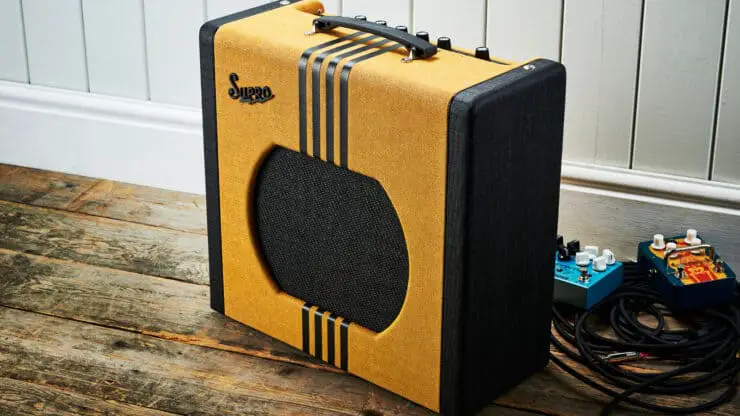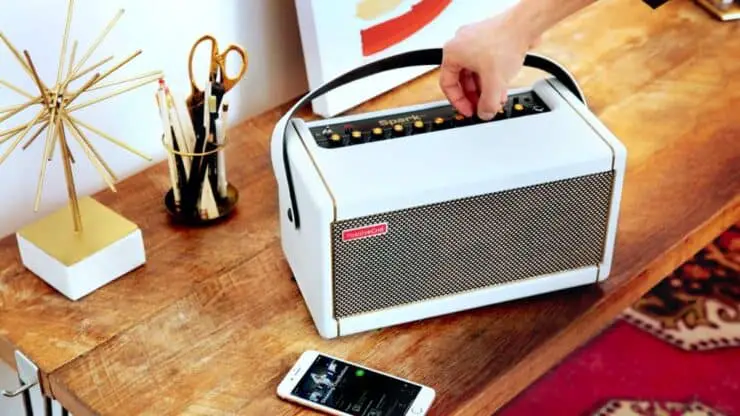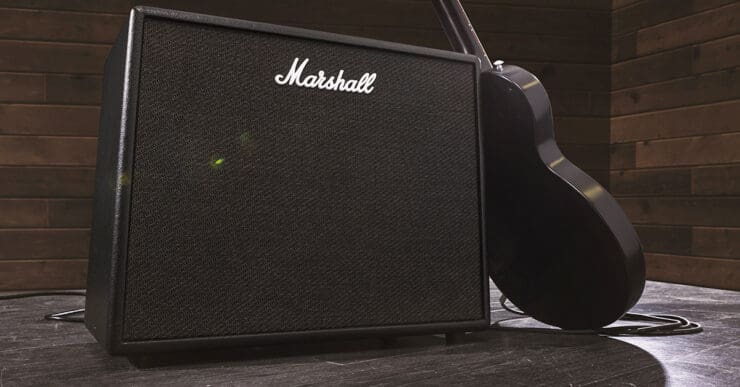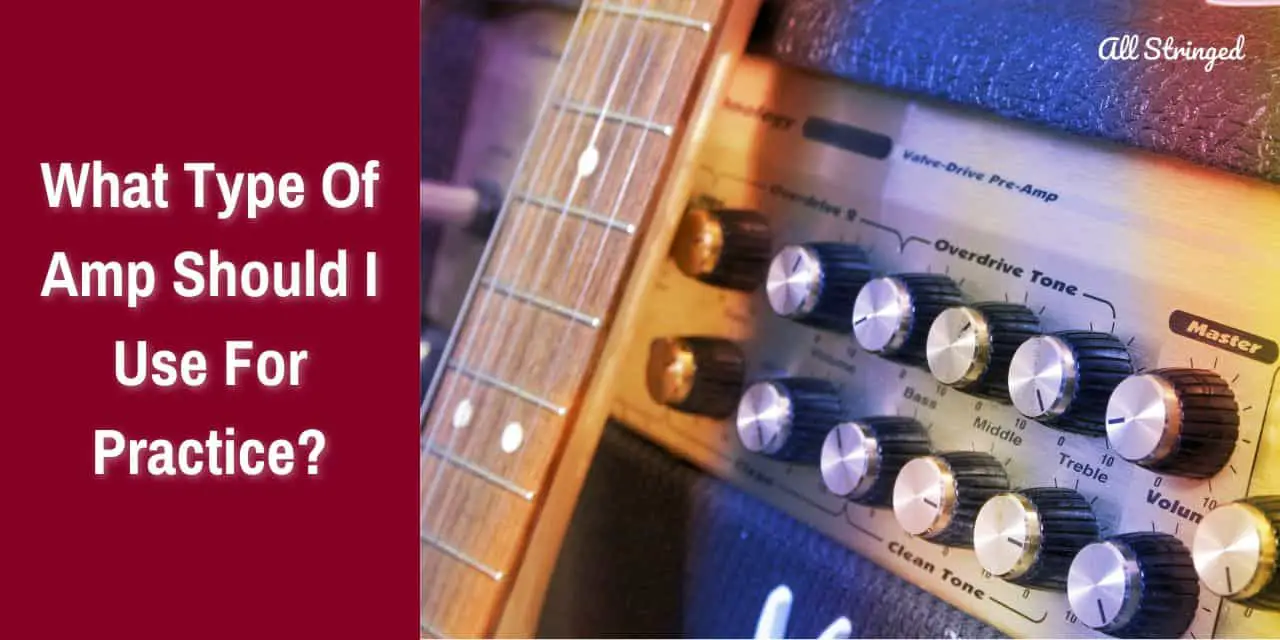If you are a guitar player, chances are you have asked yourself this question: what type of amp should I use for practice? With the overwhelming variety of amps available on the market, it can be difficult to determine which one is the best fit for your needs. Whether you are a beginner or an experienced guitarist, this article aims to provide you with the answers you are looking for, so keep on reading to learn more!
What is a guitar practice amp?
A guitar practice amp is essentially an amp designed for use during guitar practice sessions. These amps are typically small and portable. These devices offer a way for guitarists to practice without disturbing people around them. Many guitar practice amps also include different features such as headphone jacks and auxiliary input jacks. These features will allow you to use them for silent practice or jamming along with other instruments or music.
You’ll have to adjust your playing technique if you want your electric guitar to sound different from a regular guitar, as it does through an amp. An amp can cover a wide range of sins, but it could also expose them. You will sound even better if you are able to play the guitar well without an amplifier. The sound can be made even better if you amplify the sound. Do you really require a practice amp for practicing scales? Does it take a lot of rubbing for damaging the guitar?
ALSO READ: Best Practice Amp: Top 7 Picks to Play Anywhere!
An acoustic guitar is essentially the same type of guitar as an electric guitar, and this will definitely help your technique. The key to having a successful guitar career would be to maintain a healthy balance between enjoying and playing.
Why do you need a practice amp?
Any musician or aspiring musician can greatly benefit from having a good practice amp. These small yet powerful devices eliminate the need to mount an entire amp or PA system on one leg. There are different wattages and speaker sizes available, allowing you to easily select one that is appropriate for your needs. Before you purchase a high-end practice amp, you need to understand why you need it.
A practice amp is not intended for replacing your existing amp of PA. Instead, it is intended for supplementing it. Start off with a 20 or 45W amp and work your way up as you improve your playing ability. The practice amp is essential for musicians of all skill and experience levels, but it’s especially useful for guitarists who are new to the genre. A guitar amp can be used for practicing your individual techniques and chords in a low-pressure setting. You will be able to upgrade your amp as you gain more and more knowledge.

What to consider when choosing a practice amp?
When it comes to choosing a practice amp, there are numerous factors that you need to consider. Whether you are a seasoned veteran or a beginner guitarist, the right practice amp could end up making a huge difference in your playing experience. Choosing the right practice amp can be overwhelming, especially with so many features and models available in the market. Here are some of the important factors that you should keep in mind when choosing a practice amp –
#1. Power rating
The power rating of a practice amp is one of the most important factors that you should consider. It will determine how loud the amp can get and how well it can handle different styles and genres of music. For most practice settings, getting a 10 to 20W amp will be more than sufficient.
However, if you intend to play with other musicians or in a larger space, you might require an amp with a higher power rating. The higher the wattage, the louder the amp will be. If you play at home, you might not require many wattages. However, if you intend to play with others, you will require an amp that has enough wattage that can be heard over the other instruments.
#2. Speaker size
The size of the speaker will be another key factor to consider. The larger the speaker, the more volume and low-end response the amp will produce. For practice situations, a speaker size of 8 to 10 inches is typically sufficient. However, if you’re looking for a more powerful sound or plan on playing in bigger spaces, you might want to consider a larger speaker.
When playing at home, going with a smaller amp will be smarter as it won’t take up a lot of space. Meanwhile, if you intend to take the amp to practice sessions or live gigs, then you will want something that is easy to transport.
#3. Tone controls
Tone controls are another key feature to consider when you are choosing a practice amp. They will allow you to adjust the EQ of the amp for achieving the tone you want. Look out for an amp with a basic set of tone controls, including bass, treble, and mid. Some amps might also come with additional controls, such as contour or presence, which will help you further shape your sound. Sound quality should also be considered. Ideally, you will want something that can produce the sound that you are looking for.
#4. Effects
Some practice amps also come with built-in effects, such as delay, reverb, chorus, and distortion. These effects can help in creating a wider range of sounds and styles, which makes the amps much more versatile. If you are just starting out, a few basic effects could be a great way of experimenting with different sounds and styles.
#5. Connectivity
The connectivity options on a practice amp will also be an important factor to consider. You should look for an amp having a headphone jack, so you can practice without disturbing other people. You might also look for an amp with a line-in jack, so you can connect an MP3 player or other audio source to play along with your favorite tracks.
#6. Price
The price of the practice amp is another factor that you should consider. Practice amps are available in a wide range of prices, from under $50 to more than $1,000. You will want to look for an amp that fits your budget while also meeting your needs in terms of features and sound quality.
#7. Brand and reputation
The brand and reputation of the amp manufacturer are also key factors that you should consider. Some brands are known for manufacturing high-quality amps whereas others tend to be more budget-friendly. It is also important that you carry out your research and read reviews before you make the purchase.
#8. Durability
Lastly, you will want to consider the durability of the practice amp. A practice amp that is built to last will save you a lot of money eventually, as you won’t need to replace it as frequently. Look out for practice amps having sturdy construction and good warranties.
Different types of practice amps
Guitar practice amps come in a wide variety of shapes and sizes, each one with its own set of features and benefits. Here are the different types of guitar practice amps available in the market and what makes each one unique –

#1. Solid-state amps
Solid-state amps are among the most common types of guitar practice amps. They make use of solid-state electronics for amplifying the signal from your guitar, and they are typically more affordable compared to tube amps. Solid-state amps are also pretty reliable and need little maintenance. They are an amazing choice for beginners or for players who are in need of a basic, reliable practice amp.
Solid-state amps tend to be more reliable compared to tube amps and do not need the same level of maintenance as opposed to the latter. This makes solid-state amps the superior plug-and-play choice for beginners who are looking to buy their first practice amp.
#2. Tube amps
Tube amps are another viable option for guitarists. They make use of vacuum tubes for amplifying the signal from the guitar, which gives them the warm, rich sound that guitarists love. Tube amps are typically more expensive compared to solid-state amps and require a higher level of maintenance. But for many players, the tone these amps provide is well worth the extra cost and effort.
#3. Modeling amps
Modeling amps are designed for simulating the sound of different types of amps, including solid-state amps and tube amps. They make use of digital technology for creating a wide range of tones. These amps also come with built-in effects like delay, reverb, and distortion. Modeling amps are an amazing choice for guitarists who want a high level of versatility in their practice amp.
#4. Hybrid amps
Hybrid amps are a combination of tube and solid-state amps. They make use of a solid-state preamp for sharing the tone of the guitar signal, while using the tube power amp for amplifying the signal. This will give them the warmth and richness of a tube amp, with the reliability and affordability of a solid-state amp. Hybrid amps are a great choice for guitarists who want a tube-like tone, but without the extra cost and maintenance of a full tube amp.
As mentioned above, hybrid amps feature the best bits of the tube and solid-state amps in one device. While some vintage hybrid amps come with tube power sections and solid-state preamps, most modern practice amps feature a solid-state power amp section and a tube preamp section.
#5. Mini amps
Mini amps are small, portable practice amps that are designed to be used at home or on the go. These amps are typically battery-powered, and they feature a single speaker, which means they don’t produce a lot of volume or bass response. However, these amps are a great choice for guitarists who want a portable practice amp that they can carry anywhere they go.
#6. Bluetooth amps
Bluetooth amps are the newer type of guitar practice amps that allow you to connect your electric guitar to your phone or other Bluetooth-enabled devices. These amps come with built-in effects and a wide variety of tone-shaping options. Further, they also allow you to play along with your favorite backing tracks or latest hits.
How to test a practice amp?
When it comes to testing guitar practice amps, there are various things that you should consider aside from checking the power rating, speaker size, effects, tone controls, and build quality. Here are the steps through which you can carry out the testing of your practice amp for your needs –
#1. Listen to sound samples
One of the best ways to test and get a sense of what a practice amp should sound like is to listen to sound samples online. Many manufacturers offer sound samples of their amps on their official websites, as well as on social media platforms like YouTube, Instagram, SoundCloud, etc. You should take time to listen to a variety of different sound samples and make note of the amps that catch your ear.
#2. Test the amp in person
While listening to the sound samples online can be quite helpful, there is no substitute for testing a practice amp in person. If possible, you should try to visit a music store and test different practice amps. Bring your guitar along with you and play a wide variety of different styles of music to get a sense of how the practice amp sounds and feels. You should ensure that you adjust the settings on the amp to see how it is responding to different tones and volume settings.
#3. Consider the playing environment
Another key factor that you should consider when testing a practice amp would be the playing environment. If you’re playing at home in a small room, a smaller amp having a lower power rating will be more suitable for your needs. For home use, you will not need an amp that uses more than 20W of power. Having a high-powered amp at your house will be like having a race car that isn’t allowed to drive over 20 mph.
Most practice amps feature a single speaker between 8–12 inches in diameter. However, if you’re playing in a band and need a practice amp for practicing or for performing in larger venues, you will require a larger amp with a higher power rating to cut through the mix.
#4. Look for versatility
When you are testing a practice amp, it’ll be important to look at the versatility of the amp in terms of tone and effects. Make sure that the amp offers enough versatility that it can suit a wide variety of different playing styles and genres. A decent guitar practice amp should be able to cover numerous musical genres, from jazz to country to metal and more.
Experienced players may want to go for a one-trick pony amp that can help them nail down the desired tones. You should look for practice amps that have multiple channels or settings that allow you to switch between clean and distorted tones, as well as amps having built-in effects like reverb, chorus, and delay. Meanwhile, for beginners, it’ll be best to select a practice amp that gives you the flexibility to experiment. This will be better than being stuck with one sound and will make practice more fun.
#5. Test the price
Lastly, it will be important to consider your budget when you are testing a guitar practice amp. While there are definitely high-end amps that offer top-notch sound quality, there are also many budget-friendly options that offer amazing performance at a lower price point. You should determine how much you are willing to pay and ensure that you test practice amps that fall within the determined price range.
Budget considerations for practice amps
When shopping for a guitar practice amp, one of the most important considerations will be your budget. There are many different options available on the market, ranging from entry-level practice amps to high-end models with advanced features. One way of stretching your budget would be to consider buying a used amp instead of a brand-new one. Moreover, it’ll be important that you consider the cost of accessories, such as cables, stands, and pedals when calculating the overall budget.

New vs. used practice amps
New practice amps will come with the assurance of a manufacturer’s warranty and be in pristine condition. However, they can be much more expensive compared to used models. Used amps can be a cost-effective option for guitarists on a budget, but it is important that you consider the condition of the amp and the seller’s reputation before you make a purchase. Some factors that you should consider when buying a used practice amp include the age of the practice amp, how often it has been used, and whether any modifications or repairs have been made.
Generally, buying a used amp can be a great way of saving money without sacrificing quality. However, it’ll be important to take time to research the specific amp that you are interested in and inspect it carefully before you make the purchase.
Cost of accessories
In addition to the cost of the practice amp itself, it’ll be important to factor in the cost of accessories when you decide the budgeting for a practice amp. Accessories such as pedals, cables, and stands can be important components of a practice set up, but they can also add up pretty quickly in terms of cost.
When purchasing accessories, it will be important to look for high-quality components that last long. Cheap cables and pedals might seem like a good deal, but they can break or fail after a few uses. This can result in frustration and additional expenses eventually.
One way of saving money on accessories would be to purchase them as a package deal with the practice amp. Many retailers offer bundle deals that include everything that you need for getting started, including pedals, cables, and stands. These packages can be a cost-effective way of getting everything you need for your practice setup at once.
FAQs
What are the different types of amps for practicing guitar?
There are several types of amps available for practicing guitar, including solid state amps, tube amps, modeling amps, hybrid amps, and portable amps. Each type of amp has its own unique sound, features, and benefits, so it’s important to consider which type of amp is best for your needs.
What are the advantages and disadvantages of each type of amp for practice?
Solid state amps are known for their affordability, durability, and reliability. However, they may lack the warmth of other types of amps and may not produce classic amp tones. Tube amps are known for their rich and warm sound and highly responsive nature, but they can be expensive and require maintenance. Modeling amps offer versatility and the ability to simulate classic amp tones, but may not sound as authentic as tube amps. Hybrid amps offer the best of both worlds, but may not be as versatile as modeling amps. Portable amps are lightweight and convenient for practice on the go, but may not have as much power as larger amps.
What should I consider when choosing an amp for practice?
When choosing an amp for practice, you should consider the type of guitar and playing style, volume and tone control, power and speaker size, budget, available space for storage, and portability needs. It’s important to find the right balance of these factors to ensure you get an amp that meets your needs and provides a great playing experience.



